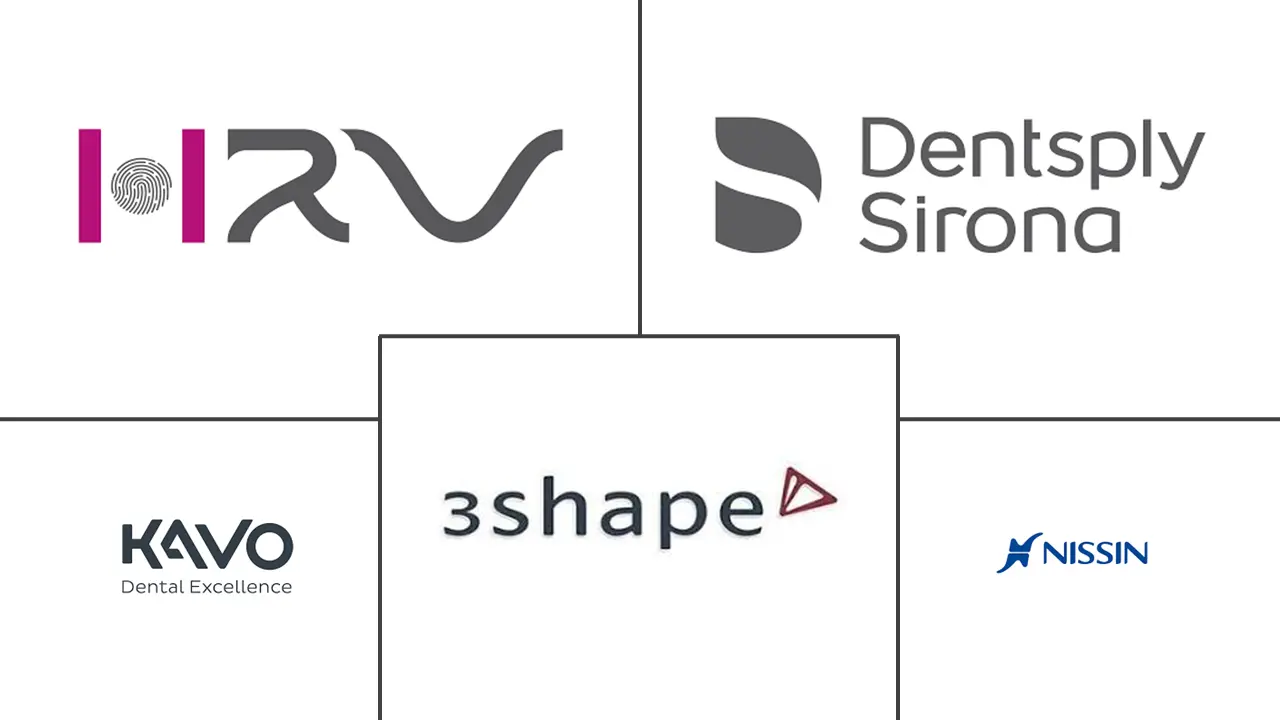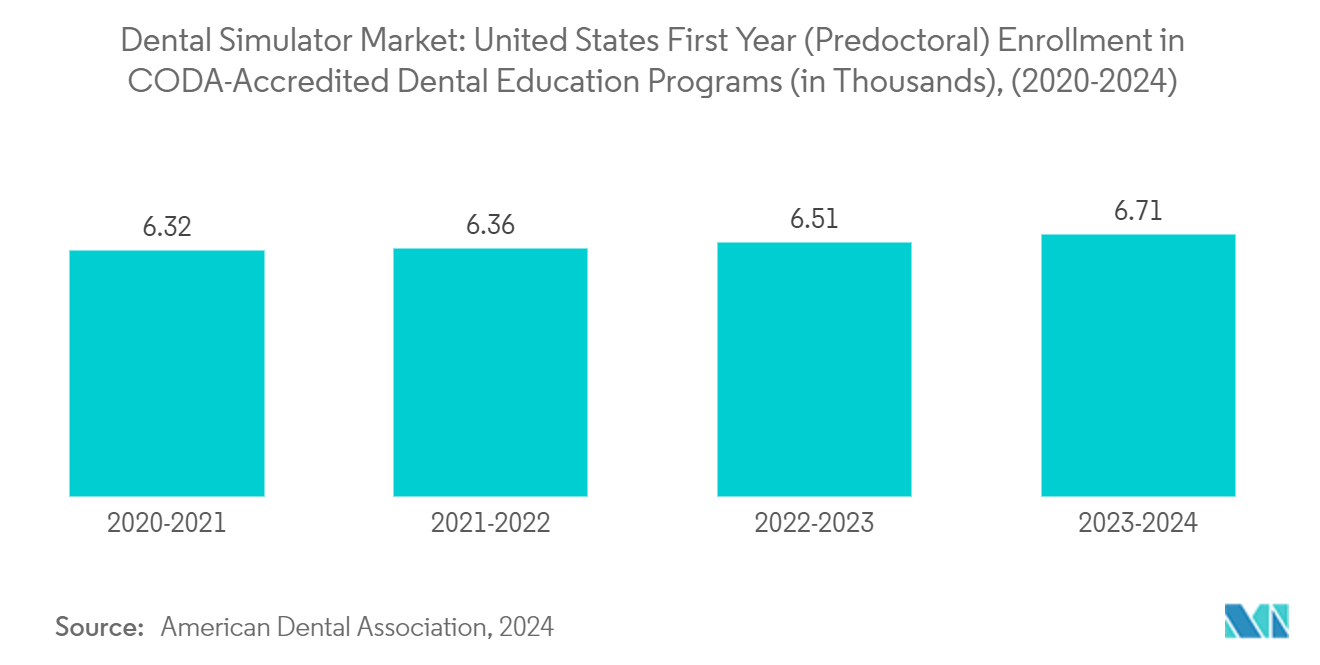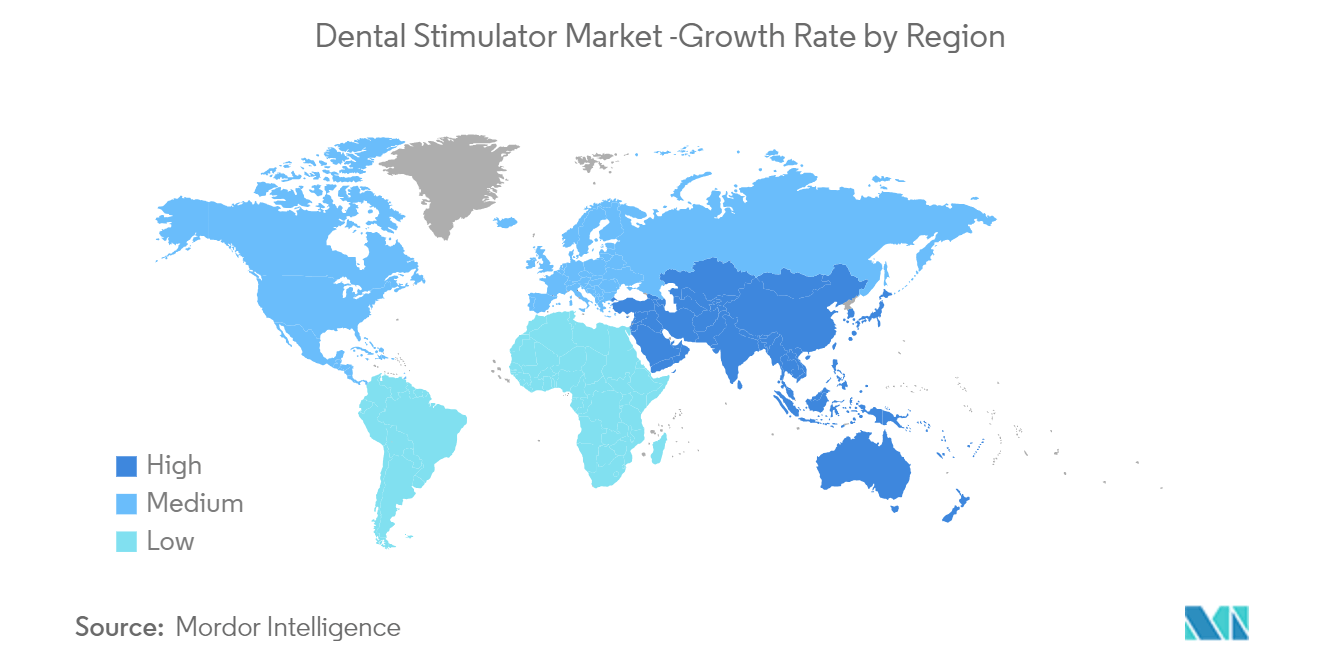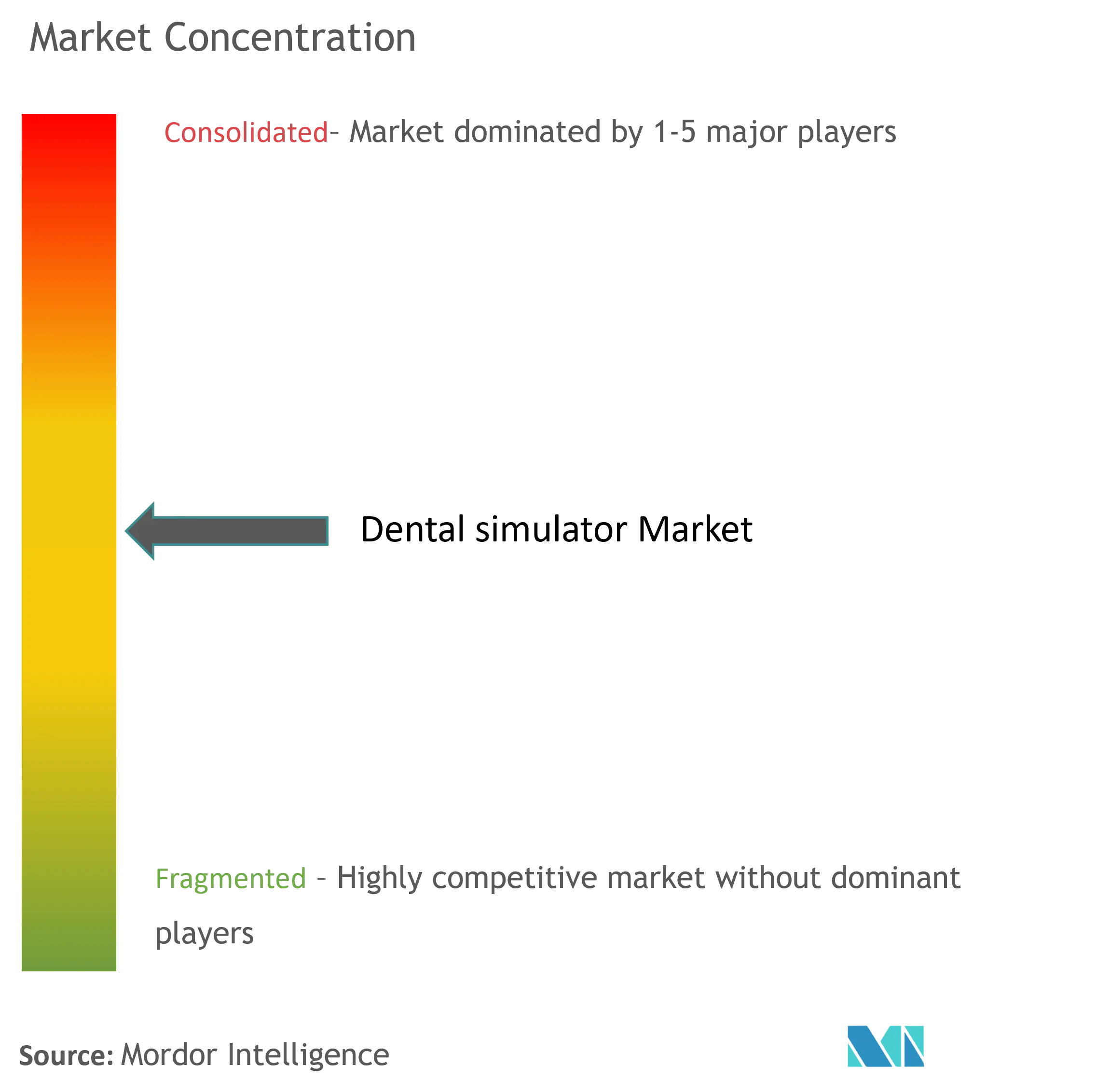Dental Simulator Market Size

| Study Period | 2019 - 2029 |
| Market Size (2024) | USD 433.90 Million |
| Market Size (2029) | USD 654.20 Million |
| CAGR (2024 - 2029) | 8.60 % |
| Fastest Growing Market | Asia Pacific |
| Largest Market | North America |
| Market Concentration | Medium |
Major Players
*Disclaimer: Major Players sorted in no particular order |
Dental Simulator Market Analysis
The Dental Simulator Market size is estimated at USD 433.90 million in 2024, and is expected to reach USD 654.20 million by 2029, growing at a CAGR of 8.60% during the forecast period (2024-2029).
The dental simulator market is experiencing notable growth owing to various technological advancements. Modern advancements in dentistry have significantly impacted the progress and practice of dentistry. Augmented reality (AR) and virtual reality (VR) are becoming increasingly common in modern dentistry because of their impact on changing the patient’s experience. Clinicians can use VR technology to show their patients the expected outcomes before they undergo dental procedures. Additionally, AR and VR can be implemented to overcome dental phobia, which pediatric patients commonly experience. The COVID-19 pandemic forced several dental schools and institutes to change their traditional teaching methods to an alternate teaching mode, which became a significant driving factor for the dental simulator market. It resulted in the development of new techniques that led to product launches. For instance, in October 2023, Dentsply Sirona launched the SureSmile Simulator, an application within DS Core that is designed to support patient conversations about the benefits of SureSmile Aligner Treatment by showing the expected outcome even before the start of the therapy.
The rising technological advancement and increasing number of dental schools and institutes are among the significant factors driving the growth of the dental simulator market. Cutting-edge technology permeates dentistry, and practitioners are increasingly adopting innovative solutions to enhance patient care and treatment outcomes. The commonly used traditional digital technologies use a digital scanner to obtain a digital image. The image is then used to modify the different dental aspects of the patients. Finally, the modifications are transferred to the digital wax-up. However, VR takes laser scans of the patient’s teeth and other required oral and extraoral structures. The scans are fed into a computer that forms a 3D model of the same, which is then loaded into a simulator. The surgeon/students can practice using this simulator and perform evaluations before the procedure is performed on a real patient.
Due to the increasing acceptance of dental simulator products, there is a rise in the development of advanced complementary products as well. For instance, in January 2024, Align Technology Inc. launched the iTero Lumina intraoral scanner, consisting of an approximately three times wider field of capture in a 50% smaller and 45% lighter wand. The new scanner is anticipated to complement the Exocad CAD/CAM software for digital orthodontics and restorative dentistry. Such innovations have not only improved treatment outcomes but have also enhanced the overall patient experience.
The increasing number of dental education programs is a major driving factor for the market's growth. The expansion of such programs creates a parallel demand for advanced training tools and equipment, including dental simulators. Dental simulators play a crucial role in practical training scenarios, allowing students to refine their skills in a controlled environment. According to the Commission on Dental Accreditation dental education program enrollment and graduates trends report, 2023-24, published in March 2024, there was a 9.1% increase in the number of accredited predoctoral dental education programs in the US in 2023 compared to 2019. For advanced programs, the increase was 0.7%. Such growth in accredited programs indicates the rising interest in such programs, which is anticipated to boost the application of these simulators for training the students enrolling in these programs.
Rising technological advancements and an increasing number of dental programs are driving the market's growth. However, the increasing investment cost is restraining the dental simulator market’s growth.
Dental Simulator Market Trends
The Hardware Segment is Expected to Witness Significant Growth Over the Forecast Period
Hardware, comprising physical devices and equipment, is central to the dental simulation process and influences diagnostic precision and treatment efficacy. Dental professionals prioritize tangible tools, such as simulation units, which enable realistic training scenarios and procedural practice. Additionally, advancements in hardware technology, including sensor integration, haptic feedback, and precision engineering, are some of the factors driving the market's growth. According to a published report by the National Center for Biotechnology Institute (NCBI), the Unidental MR Simulator has good face validity for tooth preparation.
The durability and longevity of hardware components make them a sustainable investment for dental facilities, leading to widespread adoption. The physicality of dental professionals solidifies their position as an integral component of dental practices. frasaco GmbH, KaVo Dental, NISSIN DENTAL PRODUCTS INC., and Dentsply Sirona are some of the major manufacturers that offer hardware for the dental simulation market.
Integrating artificial intelligence (AI) algorithms within dental simulation hardware has significantly contributed to its effectiveness. AI-driven simulation can adapt to individual learning styles, provide personalized feedback, and track progress over time. This intelligent functionality enhances the efficiency of dental education and training, making it a valuable asset in dental institutions and professional development programs. Collaborative learning environments further influence the dominance of the hardware segment in dental simulation. Multi-user hardware setups enable dental teams to engage in a collaborative simulation, facilitating communication and teamwork among practitioners, enhancing the overall learning experience, and preparing a dental professional for effective interdisciplinary collaboration in real-world clinical settings.
Therefore, technological advancement, durability, and longevity of the component are some of the key factors expected to drive the segment's growth over the forecast period.

North America is Expected to Dominate the Dental Simulator Market
North America is expected to dominate the market as dental professionals in the region are more inclined to invest in cutting-edge equipment to enhance patient care and stay at the forefront of dental practices. In July 2023, according to The Elite Practice, the Canada Digital Adoption Program (CDAP) announced that it would provide USD 4 billion in total funding to help small- to medium-sized businesses embrace digital transformation.
A rise in dental tourism and a well-established healthcare infrastructure further contribute to market growth. According to PlacidWay, LLC, Mexico and Costa Rica are the cheapest and best countries for dental tourism in the world, where a patient can receive affordable prices for the same dental treatments compared to the other countries.
Moreover, the region serves as a hub for innovation, with companies continuously pushing the boundaries of simulation technology. The proactive approach of regulatory bodies in ensuring product quality and patient safety enhances the credibility of dental simulators in the region, and the presence of leading manufacturers and research institutions further influences market growth.
Therefore, the inclination to invest in cutting-edge equipment to enhance patient care, stay at the forefront of dental practice, and rise in dental tourism are factors expected to drive the market’s growth over the forecast period.

Dental Simulator Industry Overview
The dental simulator market is moderately consolidated due to a few companies commanding significant market share. The competitive landscape includes an analysis of a few international and local companies that hold substantial market share and are well known, including Dentsply Sirona, NISSIN DENTAL PRODUCTS INC., KaVo Dental, 3Shape A/S, and HRV Simulation.
Dental Simulator Market Leaders
-
Dentsply Sirona
-
3Shape A/S
-
NISSIN DENTAL PRODUCTS INC.
-
KaVo Dental
-
HRV Simulation.
*Disclaimer: Major Players sorted in no particular order

Dental Simulator Market News
- April 2024: The University of Saskatchewan’s (USask) College of Dentistry announced purchasing and integrating ten haptic dental simulators to ensure hands-on, technology-driven education. The simulators were installed to provide students with immersive, near-reality training across various dental procedures, from implantology to operative dentistry.
- July 2023: The University of Portsmouth stated in its article that UNI-SIM is a haptic and virtual reality training simulator for institutions, revolutionizing medical education where any simulation company can distribute their software on the simulator and empowering future doctors with its haptic and virtual reality training software.
Dental Simulator Market Report - Table of Contents
1. INTRODUCTION
1.1 Study Assumptions and Market Definition
1.2 Scope of the Study
2. RESEARCH METHODOLOGY
3. EXECUTIVE SUMMARY
4. MARKET DYNAMICS
4.1 Market Overview
4.2 Market Drivers
4.2.1 Rising Technological Advancements
4.2.2 Increasing Number of Dental Education Programs
4.3 Market Restraints
4.3.1 Increased Investment Cost
4.4 Porter's Five Force Analysis
4.4.1 Threat of New Entrants
4.4.2 Bargaining Power of Buyers/Consumers
4.4.3 Bargaining Power of Suppliers
4.4.4 Threat of Substitute Products
4.4.5 Intensity of Competitive Rivalry
5. MARKET SEGMENTATION (Market Size by Value - USD)
5.1 By Component
5.1.1 Hardware
5.1.2 Software
5.2 By Application Outlook
5.2.1 Dental Training & Education
5.2.2 Treatment Planning
5.3 By End User
5.3.1 Dental Schools
5.3.2 Hospitals
5.3.3 Dental Clinics
5.4 Geography
5.4.1 North America
5.4.1.1 United States
5.4.1.2 Canada
5.4.1.3 Mexico
5.4.2 Europe
5.4.2.1 Germany
5.4.2.2 United Kingdom
5.4.2.3 France
5.4.2.4 Italy
5.4.2.5 Spain
5.4.2.6 Rest of Europe
5.4.3 Asia-Pacific
5.4.3.1 China
5.4.3.2 Japan
5.4.3.3 India
5.4.3.4 Australia
5.4.3.5 South Korea
5.4.3.6 Rest of Asia-Pacific
5.4.4 Rest of the World
6. COMPETITIVE LANDSCAPE
6.1 Company Profiles
6.1.1 Dentsply Sirona Inc.
6.1.2 Nissin Dental Products Inc.
6.1.3 KaVo Dental
6.1.4 3Shape A/S
6.1.5 HRV Simulation
6.1.6 VOXEL-MAN
6.1.7 Tangshan UMG Medical Instrument Co. Ltd
6.1.8 PreVu Software LLC
6.1.9 frasaco GmbH
6.1.10 Image Navigation
6.1.11 Morita Group
- *List Not Exhaustive
7. MARKET OPPORTUNITIES AND FUTURE TRENDS
Dental Simulator Industry Segmentation
As per the scope of the report, a dental simulator is a training tool used in dental education to simulate various aspects of dental procedures, allowing students to practice and develop their skills in a controlled and realistic environment before working on actual patients.
The dental simulator market is segmented by component, application outlook, end user, and geography. The market is segmented by component into hardware and software. The market is segmented by application outlook into dental training & education and treatment planning. Based on end user, the market is segmented into dental schools, hospitals, and dental clinics. By geography, the market is segmented into North America, Europe, Asia-Pacific, and Rest of the World. The report also offers the market sizes and forecasts for 13 countries across the regions. For each segment, the market sizing and forecasts were made on the basis of value (USD).
| By Component | |
| Hardware | |
| Software |
| By Application Outlook | |
| Dental Training & Education | |
| Treatment Planning |
| By End User | |
| Dental Schools | |
| Hospitals | |
| Dental Clinics |
| Geography | ||||||||
| ||||||||
| ||||||||
| ||||||||
| Rest of the World |
Dental Simulator Market Research FAQs
How big is the Dental Simulator Market?
The Dental Simulator Market size is expected to reach USD 433.90 million in 2024 and grow at a CAGR of 8.60% to reach USD 654.20 million by 2029.
What is the current Dental Simulator Market size?
In 2024, the Dental Simulator Market size is expected to reach USD 433.90 million.
Who are the key players in Dental Simulator Market?
Dentsply Sirona, 3Shape A/S, NISSIN DENTAL PRODUCTS INC., KaVo Dental and HRV Simulation. are the major companies operating in the Dental Simulator Market.
Which is the fastest growing region in Dental Simulator Market?
Asia Pacific is estimated to grow at the highest CAGR over the forecast period (2024-2029).
Which region has the biggest share in Dental Simulator Market?
In 2024, the North America accounts for the largest market share in Dental Simulator Market.
What years does this Dental Simulator Market cover, and what was the market size in 2023?
In 2023, the Dental Simulator Market size was estimated at USD 396.58 million. The report covers the Dental Simulator Market historical market size for years: 2019, 2020, 2021, 2022 and 2023. The report also forecasts the Dental Simulator Market size for years: 2024, 2025, 2026, 2027, 2028 and 2029.
Dental Simulator Industry Report
Statistics for the 2024 Dental Simulator market share, size and revenue growth rate, created by Mordor Intelligence™ Industry Reports. Dental Simulator analysis includes a market forecast outlook for 2024 to 2029 and historical overview. Get a sample of this industry analysis as a free report PDF download.



